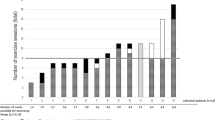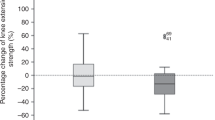Abstract
Increasing evidence supports that individualised exercise is safe and beneficial for adults treated with allogeneic bone marrow transplantation (alloBMT), although this is not part of standard care and no research has investigated group-based interventions. This study aimed to determine safety, feasibility and exploratory effects of a supervised group-based inpatient and subsequent home-based exercise programme in alloBMT. This single-site prospective cohort study included consecutive adults treated with alloBMT for haematological disease. All participants received usual care in addition to the protocolised exercise programme pre-transplant until 60 days post transplant. The primary outcome was feasibility; secondary outcomes included exercise capacity, frailty, health-related quality of life and strength. Consent rate was 100% (n = 42); 83% (n = 35) completed all aspects of the intervention and outcome testing; of those, 83% (n = 29) attended ≥2 group-exercise sessions per week; no adverse events occurred. Emotional well-being significantly improved over time, which may highlight benefits of group-based intervention. Other outcomes significantly declined from pre-BMT to hospital discharge, with some improvement at 60 days post-BMT. Participants with early signs of frailty demonstrated the greatest decline in outcomes. Group-based exercise was safe and feasible; observations from this study highlight the importance of baseline identification of frailty to target intervention at those who need it most.
This is a preview of subscription content, access via your institution
Access options
Subscribe to this journal
Receive 12 print issues and online access
$259.00 per year
only $21.58 per issue
Buy this article
- Purchase on Springer Link
- Instant access to full article PDF
Prices may be subject to local taxes which are calculated during checkout


Similar content being viewed by others
References
Baker KS, Ness KK, Weisdorf D, Francisco L, Sun C-L, Forman S, et al. Late effects in survivors of acute leukemia treated with hematopoietic cell transplantation: a report from the Bone Marrow Transplant Survivor Study. Leukemia. 2010;24:2039–47.
Abo S, Ritchie D, Denehy L, Panek-Hudson Y, Irving L, Granger CL. A hospital and home-based exercise program to address functional decline in people following allogeneic stem cell transplantation. Support Care Cancer. 2018;26:1727–36.
Abo S, Denehy L, Ritchie D, Lin KY, Edbrooke L, McDonald, C et al. People with haematological malignancies treated with bone marrow transplantation have improved function, quality of life and fatigue following exercise intervention: a systematic review and meta-analysis. Phys Ther. 2021. https://doi.org/10.1093/ptj/pzab130.
Knips L, Bergenthal N, Streckmann F, Monsef I, Elter T, Skoetz N. Aerobic physical exercise for adult patients with haematological malignancies. Cochrane Database Syst Rev. 2019;1:CD009075.
McCarthy B, Casey D, Devane D, Murphy K, Murphy E, Lacasse Y. Pulmonary rehabilitation for chronic obstructive pulmonary disease. Cochrane Database Syst Rev. 2015. https://doi.org/10.1002/14651858.CD003793.pub3.
Golmohammadi K, Jacobs P, Sin DD. Economic evaluation of a community-based pulmonary rehabilitation program for chronic obstructive pulmonary disease. Lung. 2004;182:187–96.
Hoffmannffmann TC, Glasziou PP, Boutron I, Milne R, Perera R, Moher D, et al. Better reporting of interventions: template for intervention description and replication (TIDieR) checklist and guide. BMJ. 2014;348:g1687.
Slade SC, Dionne CE, Underwood M, Buchbinder R, Beck B, Bennell K, et al. Consensus on exercise reporting template (CERT): modified Delphi Study. Phys Ther. 2016;96:1514–24.
Eldridge SM, Chan CL, Campbell MJ, Bond CM, Hopewell S, Thabane L, et al. CONSORT 2010 statement: extension to randomised pilot and feasibility trials. BMJ. 2016;355:i5239.
Patel AV, Friedenreich CM, Moore SC, Hayes SC, Silver JK, Campbell KL, et al. American College of Sports Medicine Roundtable Report on physical activity, sedentary behavior, and cancer prevention and control. Med Sci Sports Exerc. 2019;51:2391–402.
Wiskemann J, Dreger P, Schwerdtfeger R, Bondong A, Huber G, Kleindienst N, et al. Effects of a partly self-administered exercise program before, during, and after allogeneic stem cell transplantation. Blood. 2011;117:2604–13.
Parreira VF, Janaudis-Ferreira T, Evans RA, Mathur S, Goldstein RS, Brooks D. Measurement properties of the incremental shuttle walk test: a systematic review. Chest. 2014;145:1357–69.
Probst VS, Hernandes NA, Teixeira DC, Felcar JM, Mesquita RB, Gonçalves CG, et al. Reference values for the incremental shuttle walking test. Respir Med. 2012;106:243–8.
Guralnik JM, Simonsick EM, Ferrucci L, Glynn RJ, Berkman LF, Blazer DG, et al. A short physical performance battery assessing lower extremity function: association with self-reported disability and prediction of mortality and nursing home admission. J Gerontol. 1994;49:M85–M94.
Pavasini R, Guralnik J, Brown JC, di Bari M, Cesari M, Landi F, et al. Short physical performance battery and all-cause mortality: systematic review and meta-analysis. BMC Med. 2016;14:215.
Martin H. Is hand-held dynamometry useful for the measurement of quadriceps strength in older people? A comparison with the gold standard biodex dynamometry. Gerontology. 2006;52:154–9.
Bohannon RW, Bubela DJ, Magasi SR, Gershon RC. Relative reliability of three objective tests of limb muscle strength. Isokinet Exerc Sci. 2011;19:77–81.
Bohannon RW. Quantitative testing of muscle strength: issues and practical options for the geriatric population. Top Geriatr Rehab. 2002;18:1–17.
Bohannon RW, Schaubert KL. Test–retest reliability of grip-strength measures obtained over a 12-week interval from community-dwelling elders. J Hand Ther. 2005;18:426–7.
Schaubert KL, Bohannon RW. Reliability and validity of three strength measures obtained from community-dwelling elderly persons. J Strength Cond Res. 2005;19:717–20.
McQuellon RP, Russell GB, Cella DF, Craven BL, Brady M, Bonomi A, et al. Quality of life measurement in bone marrow transplantation: development of the Functional Assessment of Cancer Therapy-Bone Marrow Transplant (FACT-BMT) scale. Bone Marrow Transpl. 1997;19:357–68.
Craig CL, Marshall AL, Sjöström M, Bauman AE, Booth ML, Ainsworth BE, et al. International physical activity questionnaire: 12-country reliability and validity. Med Sci Sports Exerc. 2003;35:1381–95.
Santos-Lozanoantos-Lozano A, Hernández-Vicente A, Pérez-Isaac R, Santín-Medeiros F, Cristi-Montero C, Casajús JA, et al. Is the SenseWear Armband accurate enough to quantify and estimate energy expenditure in healthy adults? Ann Transl Med. 2017;5:97-–97.
Haas BK, Northam S. Measuring self-efficacy: development of the Physical Activity Assessment Inventory. South Online J Nurs Res. 2010;10:35–51.
Fried LP, Tangen CM, Walston J, Newman AB, Hirsch C, Gottdiener J, et al. Frailty in older adults: evidence for a phenotype. J Gerontol A Biol Sci Med Sci. 2001;56:M146–56.
Hegde A, Murthy HS. Frailty: the missing piece of the pre-hematopoietic cell transplantation assessment? Bone Marrow Transpl. 2018;53:3–10.
Rockwood K, Song X, MacKnight C, Bergman H, Hogan DB, McDowell I, et al. A global clinical measure of fitness and frailty in elderly people. CMAJ. 2005;173:489–95.
McLester CN, Nickerson BS, Kliszczewicz BM, McLester JR. Reliability and agreement of various InBody body composition analyzers as compared to dual-energy X-ray absorptiometry in healthy men and women. J Clin Densitom. 2020;23:443–50.
Thabane L, Ma J, Chu R, Cheng J, Ismaila A, Rios LP, et al. A tutorial on pilot studies: the what, why and how. BMC Med Res Methodol. 2010;10:1.
Australasian Bone Marrow Transplant Recipient Registry. Australasian Bone Marrow Transplant Recipient Registry Annual Data Summary 2018. Darlinghurst, NSW, Australia: ABMTRR; 2019.
Jarden M, Baadsgaard MT, Hovgaard DJ, Boesen E, Adamsen L. A randomized trial on the effect of a multimodal intervention on physical capacity, functional performance and quality of life in adult patients undergoing allogeneic SCT. Bone Marrow Transpl. 2009;43:725–37.
DeFor TE, Burns LJ, Gold EM, Weisdorf DJ. A randomized trial of the effect of a walking regimen on the functional status of 100 adult allogeneic donor hematopoietic cell transplant patients. Biol Blood Marrow Transpl. 2007;13:948–55.
Hacker ED, Mjukian M. Review of attrition and adherence in exercise studies following hematopoietic stem cell transplantation. Eur J Oncol Nurs. 2014;18:175–82.
Campbell KL, Winters-Stone KM, Wiskemann J, May AM, Schwartz AL, Courneya KS, et al. Exercise guidelines for cancer survivors: consensus statement from international multidisciplinary roundtable. Med Sci Sports Exerc. 2019;51:2375–90.
van Dongen JM, Persoon S, Jongeneel G, Bosmans JE, Kersten MJ, Brug J, et al. Long-term effectiveness and cost-effectiveness of an 18-week supervised exercise program in patients treated with autologous stem cell transplantation: results from the EXIST study. J Cancer Surviv. 2019;13:558–69.
Persoon S, Chin APaw MJM, Buffart LM, Liu RDK, Wijermans P, Koene HR, et al. Randomized controlled trial on the effects of a supervised high intensity exercise program in patients with a hematologic malignancy treated with autologous stem cell transplantation: results from the EXIST study. PLoS ONE [Electron Resour]. 2017;12:e0181313.
Baumann FT, Kraut L, Schule K, Bloch W, Fauser AA. A controlled randomized study examining the effects of exercise therapy on patients undergoing haematopoietic stem cell transplantation. Bone Marrow Transpl. 2010;45:355–62.
Hacker ED, Collins E, Park C, Peters T, Patel P, Rondelli D. Strength training to enhance early recovery after hematopoietic stem cell transplantation. Biol Blood Marrow Transpl. 2017;23:659–69.
Morishita S, Kaida K, Setogawa K, Kajihara K, Ishii S, Ikegame K, et al. Safety and feasibility of physical therapy in cytopenic patients during allogeneic haematopoietic stem cell transplantation. Eur J Cancer Care. 2013;22:289–99.
Schumacher H, Stüwe S, Kropp P, Diedrich D, Freitag S, Greger N, et al. A prospective, randomized evaluation of the feasibility of exergaming on patients undergoing hematopoietic stem cell transplantation. Bone Marrow Transpl. 2018;53:584–90.
Limbach M, Kuehl R, Dreger P, Luft T, Rosenberger F, Kleindienst N, et al. Influencing factors of cardiorespiratory fitness in allogeneic stem cell transplant candidates prior to transplantation. Support Care Cancer. 2021;29:359–67.
Lee SJ, Kim HT, Ho VT, Cutler C, Alyea EP, Soiffer RJ, et al. Quality of life associated with acute and chronic graft-versus-host disease. Bone Marrow Transpl. 2006;38:305–10.
Hamada R, Kondo T, Murao M, Miyasaka J, Yoshida M, Nankaku M, et al. Effect of the severity of acute graft-versus-host disease on physical function after allogeneic hematopoietic stem cell transplantation. Support Care Cancer. 2020;28:3189–96.
Wiskemann J, Kuehl R, Dreger P, Schwerdtfeger R, Huber G, Ulrich CM, et al. Efficacy of exercise training in SCT patients—who benefits most? Bone Marrow Transpl. 2014;49:443–8.
Friedenreich CM, Stone CR, Cheung WY, Hayes SC. Physical activity and mortality in cancer survivors: a systematic review and meta-analysis. JNCI Cancer Spectr. 2019;4:pkz080.
Acknowledgements
The authors would like to acknowledge the funding received from Royal Melbourne Hospital, Mary Elizabeth Watson Fellowship to conduct this research, and the allied health, nursing and medical staff and patients who facilitated this research.
Author information
Authors and Affiliations
Contributions
SA, DR, LD, CLG: Conception, design; data acquisition, analysis, interpretation; drafting and revising manuscript. YPH, LI: Conception, design; data interpretation; revising manuscript. All authors: Final approval of manuscript to be published.
Corresponding author
Ethics declarations
Competing interests
The authors declare no competing interests.
Additional information
Publisher’s note Springer Nature remains neutral with regard to jurisdictional claims in published maps and institutional affiliations.
Supplementary information
41409_2021_1411_MOESM1_ESM.docx
Supplementary Table 1: Change in outcomes over time using linear mixed model analysis except for self-reported PA which used Wilcoxon Signed-Rank tests.
41409_2021_1411_MOESM2_ESM.docx
Supplementary Table 2: Demographic and baseline outcomes of the six participants who had to cease the group-based inpatient intervention due to transplant complications.
Rights and permissions
About this article
Cite this article
Abo, S., Ritchie, D., Denehy, L. et al. Feasibility of early-commencing group-based exercise in allogeneic bone marrow transplantation: the BOOST study. Bone Marrow Transplant 56, 2788–2796 (2021). https://doi.org/10.1038/s41409-021-01411-w
Received:
Revised:
Accepted:
Published:
Issue Date:
DOI: https://doi.org/10.1038/s41409-021-01411-w
This article is cited by
-
Exercise in allogeneic bone marrow transplantation: a qualitative representation of the patient perspective
Supportive Care in Cancer (2022)



